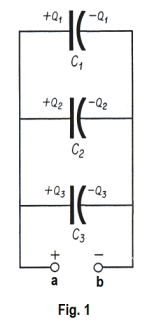
Website owner: James Miller
Prove. The equivalent capacitance CE of n capacitors C1, C2, ... , Cn connected in parallel is
1) Cn = C1 + C2 + ... + Cn

where C1, C2, ... , Cn are the capacitances of the capacitors.
Proof. We will prove it for three capacitors C1, C2, and C3.
Let a potential difference Vab be applied across the terminals a and b of the parallel network shown in Fig. 1. The potential difference across each of the capacitors is Vab, however the charges on the different capacitors is different. The charges on the capacitors are
2) Q1 = C1Vab Q2 = C2Vab Q3 = C3Vab
The total charge Q on the network is
3) Q = Q1 + Q2 + Q3
The equivalent capacitance CE is that of a single capacitor which would acquire the same total charge Q with the same potential difference. Thus
4) Q = CEVab
Substituting 2) and 4) into 3) gives
5) CEVab = C1Vab + C2Vab + C3Vab
or
6) CE = C1 + C2 + C3
We note that the energy of the single equivalent capacitor is equal to the sum of the energies of capacitors C1, C2, and C3. The energy of the equivalent is ½ QVab and the sum of the energies of
capacitors C1, C2, and C3 is ½ Q1Vab + ½ Q2Vab + ½ Q3Vab = ½ QVab .